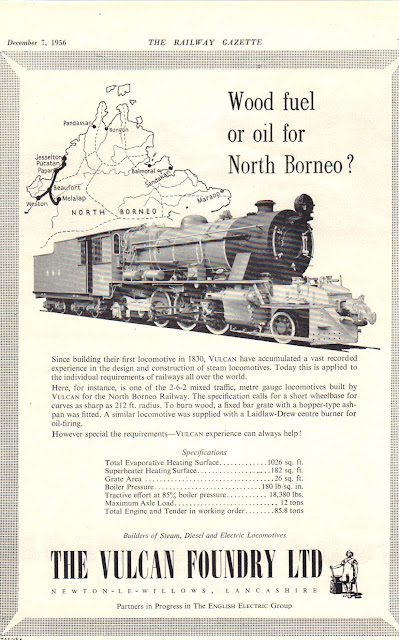This should be the concluding post of the recent series on the theme of transport which ran over the past 12 weeks!. I have always been fascinated by this area of collecting and should in future have some more other items for viewing and discussion. The following are not the best of cancellations and you would have to trust my judgement in differentiating the various types. It would at least give some idea.
An advertisement in one of the old railway magazines from a locomotive company. The depicted map of North Borneo has fictitious place names such as Bongon in the north and Balmoral near Sandakan! Balmoral is the summer residence of the British Royal family.
Update There was actually an estuary named Balmarol near Sandakan. The map was actually accurate!
The D2 is the first TPO postmark and is one of three Train P. O. cancellations. This one was recorded from 1915 to 1918.
The Train P. O. D3 came afterwards and is slightly larger in size. It was recorded in use for a little over 6 months in 1920.
These three Train POs are D4 including one in blue which is probably more uncommon. The dates ranges from 1920 to 1923. D3 and D4 are really very similar.
The Mail Train D5 was in use between 1923 and 1928. This one is in blue which is probably less common.
Here we have a Train Mail D7 and a Mail Train D6 consecutively on the same 1925 2c claret stamp. If one looks carefully at this stamp, one can make out a grand colonial type mansion mostly hidden by the fronds of the Travellers' Tree. I failed to notice this building until recently.
D6 was in use between 1929 and 1932.
The D7 was used between 1932 and 1939. It is unusual to find this cancellation in stamps other than the 4c stamp in scarlet.
The Train Mail D8 was the TPO cancellation prewar from 1939 and 1941. It was still in use after surrender to the Japanese until the end of 1942. That is supposed to be the second most uncommon of the "English" cancellations of North Borneo during the JO period after Tawau with a rating of 600.
Again, it is more usual to find this postmark on the lower values including the war tax issues.
And also nowadays the Sabah state railway system commences at Tanjung Aru, some way to the south of Kota Kinabalu.
I have quite a few copies of this 4c scarlet stamp with D7. However, on one stamp which is on the left hand side here, there is a "TRAIN" cancellation which does not fit any of the TPO marks recorded. It has similarities to the single circle Train Mail cancellations D9 and D10 used in the second half of the 1950s and early 1960s but does not fit entirely. As usual, it is a rather unclear cancellation which contributed to its uncertain status and origin.
The Jesselton K2 was used for about 11 years from 1925. It was used to cancelled ship mail and late letters.
This looks like the Sandakan K6 which can be described as a "barrel of bars" was used for late letters, ship mail etc. It was recorded in use between 1907 and 1939.
Well, this one is unrecorded. It is similar the other two but has the bars a lot closer. The stamp is also from an even earlier issue of 1894. It would seem that the last word in philately is clearly not written.
K3 was recorded for cancelling "loose mail", late letters, TPO items, ship mail etc. It was used from 1950 to 1955 according to Proud but one of our great NB collectors has it on a 5c 1964 NB overprinted Sabah stamp. It is also sometimes seen on Sarawak BMA as well as NB BMA stamps which would imply a date of use as early as 1945. The BMA stamps were eligible for use throughout British Borneo postwar.
It has always intrigued me that in the Stanley Gibbons catalogue, at the beginning of the section for North Borneo it mentions that a bar cancellation was used at one or two of the smaller post offices until 1949. I think they are referring to this cancellation as I have not ever seen a 14 bar cancel on a post war stamp.
And also there is a letter in 1954 from the district officer in Lamag in the Kinabatangan area to the south west of Sandakan, who wrote that an oval bar cancel was in use before and after the war. It was not clear whether it was just in his area covering Lamag, Sukau and Bilit or similarly in the neighbouring area of Beluran which included Labuk and Sugut. Unfortunately, prewar use of this 5 bar cancel may not have been possible if it were a salvaged japanese chop.
It is appropriate to finish with a picture of the first locomotive called Progress which was used on the North Borneo Railway system. Volume XV no.16 of the British North Borneo Herald dated 16.8.1897 states that this locomotive was shipped on 25.6.1897 and would arrive at Labuan shortly. "Progress" was a 0-4-2 tank steam locomotive which was built by Alexander Penny & Co, London.


















No comments:
Post a Comment